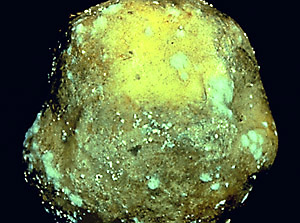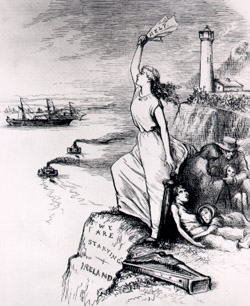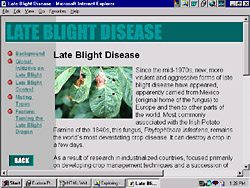by Mary Powelson and Debra Ann Inglis
Powelson, M. and Inglis, D.A. 1998. Potato Late Blight: Live on the Internet. APSnet Features. Online. doi: 10.1094/APSnetFeature-1998-0398
This year commemorates the 150th anniversary of the Great Potato Famine and this front page is designed for those who want to log onto the wealth of information that is now available on the Internet about a plant disease which is proving as challenging today as it was 150 years ago.
Late blight, caused by Phytophthora infestans, has re-emerged as a key disease in most potato and tomato producing regions of North America, largely due to new and aggressive strains of the fungus which often are insensitive to metalaxyl (Fry and Goodwin). The disease has caused considerable economic damage in all major production areas, including places where it was not considered important.
The impact of this disease has been impressive. In 1995 alone, the total cost of managing late blight in the Columbia Basin of Washington and Oregon (where the number of fungicide sprays increased from 2.5 in 1994 to 10 in 1995) is estimated to have approached $30 million (Johnson, et. al.).
As a consequence, many people have had to come to know a previously unfamiliar plant disease, quickly. This audience with an interest in potato late blight has proven diverse. Producers, processors and consumers of potatoes and tomatoes, agribusinesses, environmental groups, scientists, university and high school teachers, undergraduate and graduate science students, are some of the stakeholders, to name a few. Therefore, the demands for information about this disease are multifaceted.
|

Potato tuber showing sporulation of the Phytophthora infestans fungus
after storage under moist conditions.
|
Plant pathologists face a tremendous challenge to communicate effectively with this new late blight audience. More than ever before, it has become critical to organize, and disseminate information quickly. In the electronic environment of today, web sites are an information-rich system that is accessible to all customers. Web site users can rapidly search and retrieve information, and output can be managed and formulated to fit users' needs.
For example, some web sites have many layers of late blight management information, such as disease biology, pesticide labels, pesticide-resistance information, host plant resistance, cultural control, and comparative performance of different management options. Others have been devised specifically as an educational tool. Certain sites can be a source of links to other web pages on late blight. And, on-line forums can be held to exchange ideas and discuss important issues as was done in 1997 when APS sponsored the on-line Late Blight Workshop.
Examples of Web Sites Designed for a Specific Audience
Potato Industry and Extension
On-line Field Guide to Potato Late Blight (Oregon State University)
http://www.bcc.orst.edu/lateblight
Potato Late Blight (University of Idaho)
http://www.uidaho.edu/ag/plantdisease/lbhome.htm

A political cartoon printed in the United States at the time of the Irish potato famine.
Historical Information
The Famine - "The Times"-- and Donegal
http://www2.magmacom.com/~jward/famcont.html
The Potato Famine in History
http://www.pilot.infi.net/~cksmith/famine/History.html
Stories of the Famine (Views of the Famine)
http://www.emory.edu/FAMINE/
Research Information
Potato late blight online workshop sponsored by APS. Archived transcripts of the workshop papers, discussion groups, and introduction.

Late Blight Disease (CIP). Information from the International Potato Center, La Molina, Peru.
http://cipotato.org/blight/lblight.htm

A web page from the International Potato Center in La Molina, Peru.
Various Media
In the face of the impact of late blight on information delivery via the Internet, other areas of technology transfer/education remain important. These include videos and documentaries. Each provides current information that is organized and synthesized. Importantly, these are configured to appeal to a broad audience. Videos are a low cost tool (equipment-wise) that is particularly valuable in education. Documentaries, while more costly, if aired on public television, deliver information to an audience who might otherwise not be exposed to the issues or be familiar with plant pathology.
TV Documentary
Hot Potatoes - A one-hour public television documentary about potato late blight produced by Oregon Public Broadcasting and KCTS Television, Seattle is to be aired in 1998. This documentary is the story of the 'new potato crisis' in North America. It is intended for a general public television audience; however, its appeal is interdisciplinary. It will be especially useful in high schools and universities as a resource for social studies and in courses such as environmental studies, history of science, genetics, plant pathology, and plant breeding. Civic organizations, environmental groups, sustainable agricultural organizations, Future Farmers of America and 4-H groups as well as religious organizations may also be interested.
Videos
Late Blight and the Irish Potato Famine by D. M. Eastburn and C.J. D'Arcy. - Designed for college and advanced high school students, this 25-min video is a supplement for instructors who are planning to teach courses in commemoration of the 150th anniversary of the Irish Potato Famine.
Potato Late Blight by R.V. James and W.E. Fry - A short film on the development and epidemiology of late blight in susceptible and resistant populations of potatoes. It is designed for both undergraduate and graduate students of plant pathology.
Web sites, videos and documentaries can be used to introduce people to late blight, capture their interest and produce a desire to learn more. All can be used to augment the traditional means that plant pathologists have used to disseminate information about a fascinating disease in a timely manner. For your convenience the aforementioned list of links may be of value to you, the next time you surf the NET.
Literature and Teaching Aids
"The Irish Potato Famine and the Birth of Plant Pathology." This chapter from Gail L. Schumann's book
Plant Diseases: Their Biology and Social Impact provides excellent background information.
Click here to go to this chapter.
Late Blight of Tomato and Potato: A Lesson in Plant Pathology. A colorful production designed for students in introductory plant pathology courses.
Late Blight Simulation Software. A plant disease management game developed for teaching by Cornell University. Click here to learn more.
A Poem. Mike Coffey, a plant pathologist at UC Riverside, has written a poem entitled "Ireland, born again". The poem is followed by artwork designed by Jim Fitzpatrick representing Eriu, a princess of the legendary Tuatha De Dannan who gave her name to the island of Ireland.
References:
Opening these files will require the Acrobat Reader (version 3.01). For help obtaining this reader,
click here.
Feature Article, Plant Disease Online (APS) Fry, W. E., and Goodwin, S. B., 1997. Re-emergence of potato and tomato late blight in the United States. Plant Dis. 81: 1349-1357.
Economic analysis of late blight epidemic in Pacific Northwest.
Johnson, D. A., Cummings, T. F., Hamm, P. B., Rowe, R. C., Miller, J. S.,Thornton, R. E., Pelter, G. Q., and Sorensen, E. J. 1997. Potato late blight in the Columbia Basin: An economic analysis of the 1995 epidemic. Plant Dis.81:103-106.
